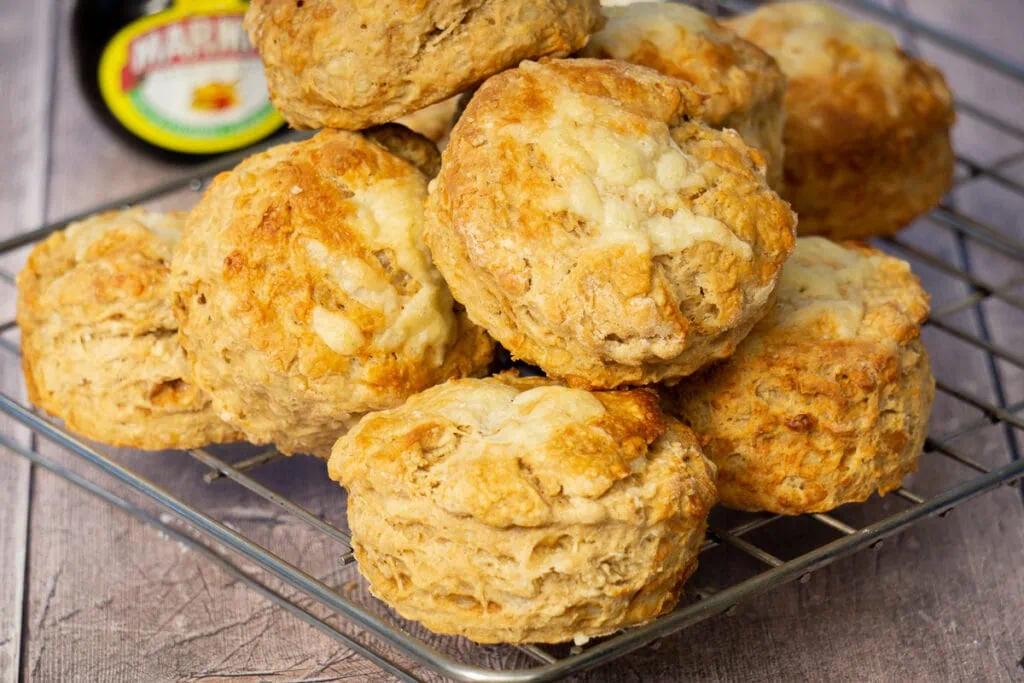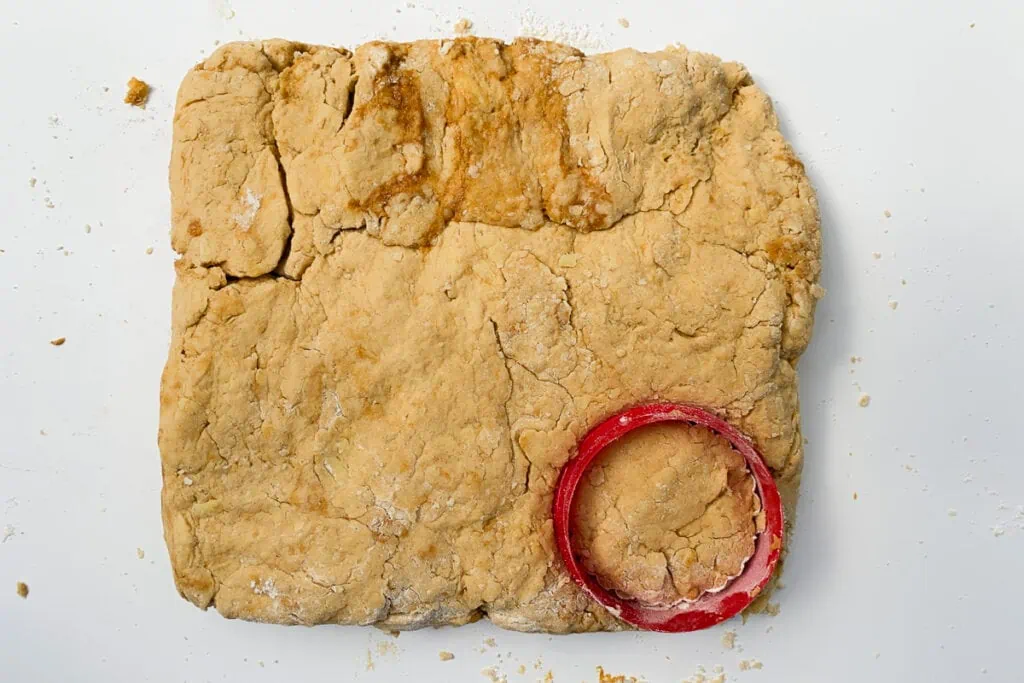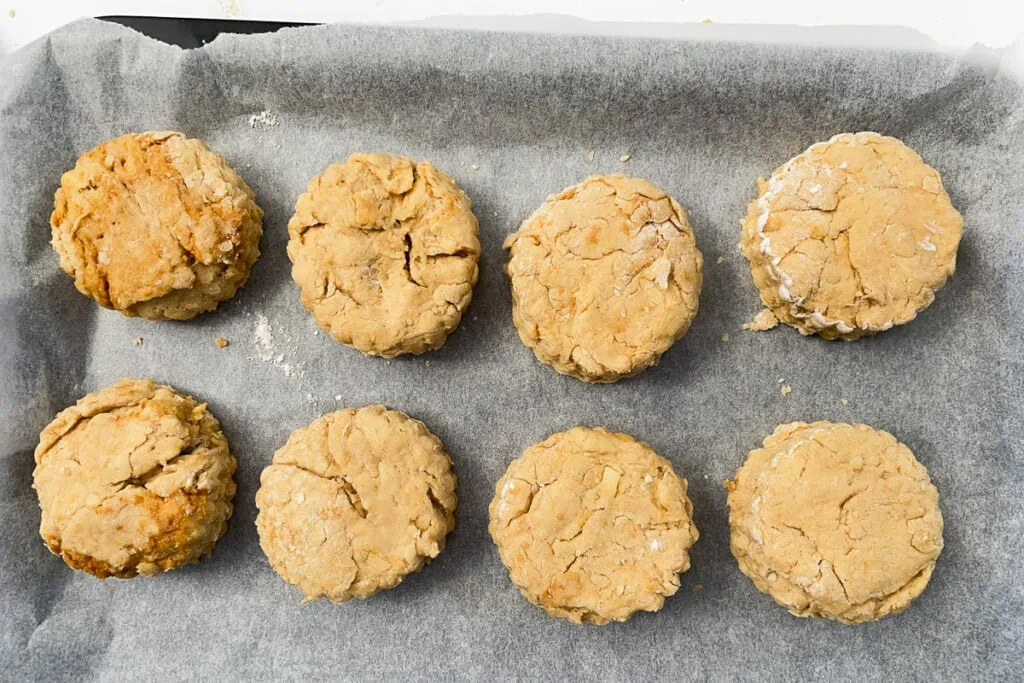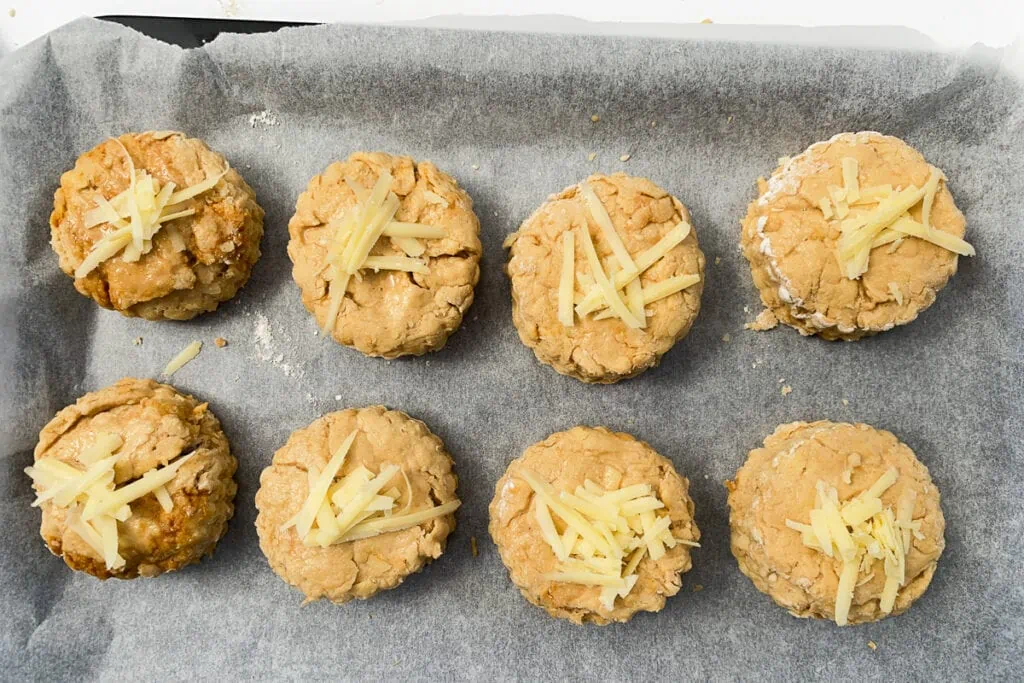You might ask, “why make Cheese and Marmite Scones?”
The simple answer is that these scrumptious savoury snacks combine three of our favourite things…cheese, Marmite and scones!

We love to keep things simple here at Scottish Scran, and we couldn’t resist bringing this tried and tested taste combination together with our own tried and tested family scone recipe. Once you master a good scone recipe it’s easy to mix things up and try some different flavours.
Without sounding too big-headed, these are amazing!
… if you like Marmite. If you don’t, you should likely stick to our regular scone recipe our tasty Treacle Scones or our Date Scones instead.
If you love a savoury scone, then you have to give our Haggis and Cheese Scones a try; you could even add Marmite, too, if you like.
Pin for later!

But a Cheese and Marmite Scone isn’t Scottish?
Now we know some readers out there get a little grumpy with us when we make things that aren’t “Scottish”.
Sorry about that, but we run this site from our own wee kitchen, and sometimes we like to make different recipes from other places in the world.
We know neither Marmite, scones or cheese, for that matter, are known to originate in Scotland, although we do talk more about where scones come from in our original scone recipe. The main thing is, that they’re all enjoyed here, and that’s good enough for us!
What is Marmite?
The star of a Cheese and Marmite Scone is unsurprisingly Marmite.
Usually, this is a breakfast spread, used on toast just like jam or peanut butter. However, it’s also a great ingredient to add to other recipes as well.
If you live in the UK, then it’s likely you’ve been familiar with Marmite for most of your life. However, for those abroad, it can be a little confusing. What is it exactly?
Marmite is a thick spread made from yeast extract that’s almost black in colour. It was discovered by accident by a German scientist as a byproduct of brewing beer. What a happy accident!
That same year, 1902, the Marmite Food Company was built in Burton on Trent, England, and Marmite has been made there ever since.
Now, as a Kiwi, Sonja would like to note here that there is also a New Zealand version of Marmite which is similar but not exactly the same as the British version. It’s even closer to a black colour and thicker, with less stickiness.
The flavour is similar, although the British version includes more sugar and caramel, and the New Zealand version is said to be less tangy. We could go into a debate about which one is better, but let’s just say that you can use either in this recipe and leave it at that!

What does Marmite taste of?
An excellent question and one that is open to some debate!
As we noted above, it’s made from yeast extract, but that doesn’t really tell you a lot. In fact, it sounds distinctly NOT delicious.
Marmite is often said to be an acquired taste, and every person has their own amount of spread they like and butter/margarine to Marmite ratio that they enjoy.
When describing tastes we often use words like sweet, salty, bitter, and sour. Another taste description is “umami”, which is the category that Marmite falls into.
It has a strong, salty flavour like no other, that is about as savoury as a taste can be. Think of a thick, meaty-tasting, dark soy sauce mixed with real ale.
Marmite has a strong smell and even stronger taste that even the company who made it admits that you either love or hate!
Basically, you just have to try it…
Let’s just add that Marmite sells over 11.6 million jars a year in the UK alone, so if you’re on the fence, give it a go!

Why is it called Marmite?
Marmite is named after a French crockery cooking pot with a lid and handles of the same name.
This is because Marmite was initially sold in earthenware pots of the same shape.
Why Marmite and Cheese?
It’s no surprise we ended up making Cheese and Marmite Scones. Despite growing up on different sides of the world, we both grew up eating both Marmite on toast and cheese and marmite sandwiches. Both are still firm favourites.
Cheese and Marmite is one of the world’s perfect combinations, in Phil’s opinion. The intense flavour of the spread just highlights the delicious bite and taste of a robust cheese like a mature cheddar.
It’s the same as combining cheese and bacon and the opposite result of mixing cheese and jam. All of which Phil is known to have between two pieces of bread. He asks not to be judged too harshly!
What cheese works best in Cheese and Marmite Scones?
A mature cheddar, in our opinion, is the perfect cheese to mix with Marmite in any recipe, but you could use any other cheese that has a bit of a kick to it.
To adjust the flavours in your Cheese and Marmite Scones, pick a milder cheddar to allow the Marmite to be the hero or an extra mature to bring the cheese to the front of the line.
How many calories are in Marmite?
Marmite is a perfect low-calorie option, with only 21 calories per serving.


Is Marmite Vegan?
Marmite is vegan, so with some slight adjustments, these Cheese and Marmite Scones are the perfect vegan treat! Use a vegan vegetable spread or vegan butter, soy milk, and vegan cheese. You may be able to use another plant-based milk but we’ve never tried any others with scones.
Sadly though, it is not Gluten-free.
What’s the difference between Scones and Biscuits?
Here’s one for all our American friends. The difference seems to be in fat and sugar content plus what they’re served with. The Brits will traditionally go with butter, jam and cream (for a plain scone), whereas our American cousins prefer gravy. Both sound great in our book!
For more information, visit our Scone recipe, as we go into more detail there.
What to serve with Cheese and Marmite Scones
Our Cheese and Marmite scones are already jam-packed full of flavour, so in this case, a little butter is all you’ll need.
They also make a great savoury scone to serve with soup! Try these instead of our bannocks or oatcakes.

Things you’ll need to make Cheese and Marmite Scones
- Large Bowl
- Pastry Blender – this makes forming breadcrumbs with the flour and butter much easier
- Microwave safe jug or bowl
- Scone Cutter – basically a biscuit cutter, or you can use large glass
- Large baking tray
- Butter Knife
Ingredients for Cheese and Marmite Scones
Yield: 12-16 Scones
Prep Time: 20 minutes
Cooking Time: 12-15 minutes
- 500g (4 Cups) Self Raising Flour
- 4 tsp Baking Powder
- 100g (1/4 Cup) Cold Cubed Butter
- 350ml whole milk approx
- 150g (1 Cup) Grated Mature Cheddar Cheese
- 2-3 Tbsp Marmite*

*How much Marmite should you use in Cheese and Marmite Scones?
If you’re planning to make Cheese and Marmite Scones rather than just plain old cheese, it’s likely you’re a fan of Marmite! However, we know that not everyone likes the same amount of flavour from Marmite.
As a guide, we LOVE Marmite and used 3 Tablespoons and thought that gave a good strong flavour. A friend tried them and didn’t even realise they were Marmite flavour at first just thought they were “savoury”. So the answer is unclear!
In this recipe, we mix in 2 Tablespoons and have another mixed through at the end. You could omit the last one if you’re not sure you want a strong flavour as it does mean you get ripples of Marmite throughout, which you can definitely taste when you hit open one.
How to Make Cheese and Marmite Scones – Step by Step Method
Pre-heat the oven to 180C Fan or 200C normal (350/390F)
Rub the cold butter and flour together until it resembles breadcrumbs. You can use your fingertips, or a Pastry Blender to start with and then your fingers to get finer crumbs.



Stir in the baking powder.
Add the cheese and stir it through.


Heat milk in a microwave safe bowl or jug until it is just warm, around 30-60 seconds. Add 2 tbsp of Marmite and stir thoroughly.
Make a well in the flour mix and pour in the milk and marmite mixture, reserving 1 tbsp to brush over the scones before baking.
Use a butter knife to bring the mixture together. If you’re adding the third tbsp of Marmite then drizzle over when half combined.


Tip the mixture onto a floured surface and use your fingertips to make sure it’s fully combined, handily it as little as possible.
Form the whole mixture into a flat square or circle just over an inch or so thick.
Use a scone cutter or large glass rim dusted with flour to cut the mixture into individual scones. Do not twist when pulling up the cutter/glass as this can lead to the scones becoming crooked as they rise. Reform the dough as necessary but continue to handle as little as possible.



Arrange the scones evenly spaced on a baking tray and brush the top of the scones with the remaining milk mixture, and sprinkle a but of extra cheese on top of each if you like.



Bake for 12-15 minutes in the middle of the oven. You’ll know they’re done when the bottom goes slightly brown and if you tap it the scone sounds hollow.
Transfer to a wire rack to cool, although they taste delicious when still warm from the oven!

How to serve Cheese and Marmite Scones?
Keep it simple and let the flavours do the talking. Just serve warm, cut in half with a little butter spread on either side.
Okay, we use a lot of butter but start with a little!
As mentioned above, you could also eat in place of a savoury scone with soup.
How to Store Cheese and Marmite Scones?
Keep them at room temp in a suitable airtight container with a lid. Place a few sheets of kitchen towel in the bottom of the container (to capture any moisture). Once your scones are inside, pop another sheet of kitchen paper on the top.
They will stay fresh for 1-2 days. After this, they go a little stale but are still okay to eat for 3-4 days and are especially good toasted.

Can you Freeze Cheese and Marmite Scones?
You can, just like plain scones. After they’ve cooled, pop them in an airtight bag with as much of the air squeezed out as possible. Defrost at room temp, then enjoy as usual. We like heating ours under the grill, so the butter melts nicely. If you are going to reheat, splash a few drips of water onto each one to add a little moisture.
They’ll last in the freezer for up to 3 months.
Can I add different cheeses to Cheese and Marmite Scones?
You certainly can. Any cheese is fair game! We would suggest something with a bit of a kick, a little on the mature side, but the cheese world is your oyster here.
One thing to note, though, is that you may need to adjust the amount of Marmite added to balance the flavour of the cheese you choose. Less is more in this case.
Can the Cheese and Marmite Scones be made Gluten-free?
Sadly not, Marmite isn’t Gluten-free.
The best way to serve Scones
Our top tip for scones, savoury or sweet, is not to cut them open when they’re hot. The knife mashes the inside of the scone, causing it to lose all of its fluffiness.
Just twist and tear the scone into two halves. Easy, right?
Easy Cheese and Marmite Scones Recipe

These Cheese and Marmite Scones combine three of our favourite things... cheese, marmite, and scones!
They're the perfect savoury snack, or lovely served with soup.
A great treat for Marmite-lovers but also one to try for those on the fence, as the Marmite can be as subtle or strong as you like, but adds a definite tasty kick to ordinary cheese scones.
Ingredients
- 500g (4 Cups) Self Raising Flour
- 4 tsp Baking Powder
- 100g (1/4 Cup) Cold Cubed Butter
- 350ml whole milk approx
- 150g (1 Cup) Grated Mature Cheddar Cheese
- 2-3 Tbsp Marmite*
Instructions
- Pre-heat the oven to 180C Fan or 200C normal (350/390F)
- Rub the cold butter and flour together until it resembles breadcrumbs. You can use your fingertips, or a Pastry Blender to start with and then your fingers to get finer crumbs.
- Stir in the baking powder.
- Add the cheese and stir it through.
- Heat milk in a microwave safe bowl or jug until it is just warm, around 30-60 seconds. Add 2 tbsp of Marmite and stir thoroughly.
- Make a well in the flour mix and pour in the milk and marmite mixture, reserving 1 tbsp to brush over the scones before baking.
- Use a butter knife to bring the mixture together. If you’re adding the third tbsp of Marmite then drizzle over when half combined.
- Tip the mixture onto a floured surface and use your fingertips to make sure it’s fully combined, handily it as little as possible.
- Form the whole mixture into a flat square or circle just over an inch or so thick.
- Use a scone cutter or large glass rim dusted with flour to cut the mixture into individual scones. Do not twist when pulling up the cutter/glass as this can lead to the scones becoming crooked as they rise. Reform the dough as necessary but continue to handle as little as possible.
- Arrange the scones evenly spaced on a baking tray and brush the top of the scones with the remaining milk mixture, and sprinkle a but of extra cheese on top of each if you like.
- Bake for 12-15 minutes in the middle of the oven. You’ll know they’re done when the bottom goes slightly brown and if you tap it the scone sounds hollow.
- Transfer to a wire rack to cool, although they taste delicious when still warm from the oven!
Notes
How much Marmite should you use?
If you're planning to make Cheese and Marmite Scones rather than just plain old cheese, it's likely you're a fan of Marmite! However, we know that not everyone likes the same amount of flavour from Marmite.
As a guide, we LOVE Marmite and used 3 Tablespoons and thought that gave a good strong flavour. A friend tried them and didn't even realise they were Marmite flavour at first just thought they were "savoury". So the answer is unclear!
In this recipe, we mix in 2 Tablespoons and have another mixed through at the end. You could omit the last one if you're not sure you want a strong flavour as it does mean you get ripples of Marmite throughout, which you can definitely taste when you hit open one.
Nutrition Information:
Yield:
12Serving Size:
1Amount Per Serving: Calories: 294Total Fat: 12gSaturated Fat: 7gTrans Fat: 0gUnsaturated Fat: 4gCholesterol: 33mgSodium: 1112mgCarbohydrates: 35gFiber: 2gSugar: 2gProtein: 10g
These values are an estimate only

Love these scones so tasty. Please do not mind the Scottish nasty people who complain about dishes not being Scottish origin. I really love what you are doing here.
As an Aussie, I think Vegemite & Cheese scones should also work!
We’ve tried this and it does work, but obviously not as well 😉
Do you think Bovril would work instead of Marmite? I quite often use Bovril on a savoury biscuit topped with butter and grated cheese.
Yes, we don’t see why not!